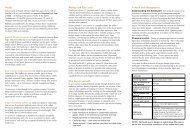Bushland Weeds Manual - Environmental Weeds Action Network
Bushland Weeds Manual - Environmental Weeds Action Network
Bushland Weeds Manual - Environmental Weeds Action Network
You also want an ePaper? Increase the reach of your titles
YUMPU automatically turns print PDFs into web optimized ePapers that Google loves.
98<br />
Chapter 8 Herbicide Use in <strong>Bushland</strong><br />
Box 8.2 Using contractors to spray African Lovegrass at Talbot Road <strong>Bushland</strong><br />
Between 1999 and 2001 infestations of African Lovegrass (Eragrostis curvula) at Talbot Road were mapped<br />
annually as part of the overall weed management strategy. The weed was found to be widespread on the<br />
tracks and bushland edges. In August 1999 contractors were employed to spot spray the infestations with a<br />
1 % solution of glyphosate. The work was carried out when the African Lovegrass was actively growing and<br />
cost $1645.<br />
A thorough examination of the site after spraying revealed that several populations of African Lovegrass had<br />
missed treatment altogether. In a number of other areas Perennial Veldgrass (Ehrharta calycina) had been<br />
mistaken for African Lovegrass. While glyphosate was appropriate to use on dense infestations of African<br />
Lovegrass growing along path edges, Perennial Veldgrass extended into the bushland and grew closely among<br />
native plants. Where Perennial Veldgrass clumps had been sprayed, off-target damage from the glyphosate was<br />
evident. If Perennial Veldgrass had been the target weed at this site a grass-selective herbicide would have<br />
been specified.<br />
Although the contractors had originally been met on site and the job discussed in detail, no maps were<br />
supplied to them and no contract outlining the work had been signed. If a contract had been signed, both<br />
parties would have had a clear understanding of exactly what was required and a means of redress when those<br />
requirements were not met.<br />
After discussions, the contractors returned to respray missed infestations. When the contractors were reemployed<br />
to follow up the work in 2000, maps of African Lovegrass distribution were supplied and a written<br />
contract signed before the work began. This time we had comeback if necessary. It was not; the contractor did<br />
a thorough, professional job.<br />
The treatment was repeated in 2001 following a summer fire that burnt through most of Talbot Road <strong>Bushland</strong><br />
in 2001. The maps were particularly useful for locating populations of resprouting African Lovegrass plants for<br />
treatment following the fire. The follow-up work in 2000 and 2001 cost $960 and $880 respectively. Maps show<br />
that the populations have decreased substantially over this time.<br />
1999 2001<br />
Distribution of African Lovegrass • at Talbot Road <strong>Bushland</strong> prior to treatment in 1999 and after treatment in 2001.



